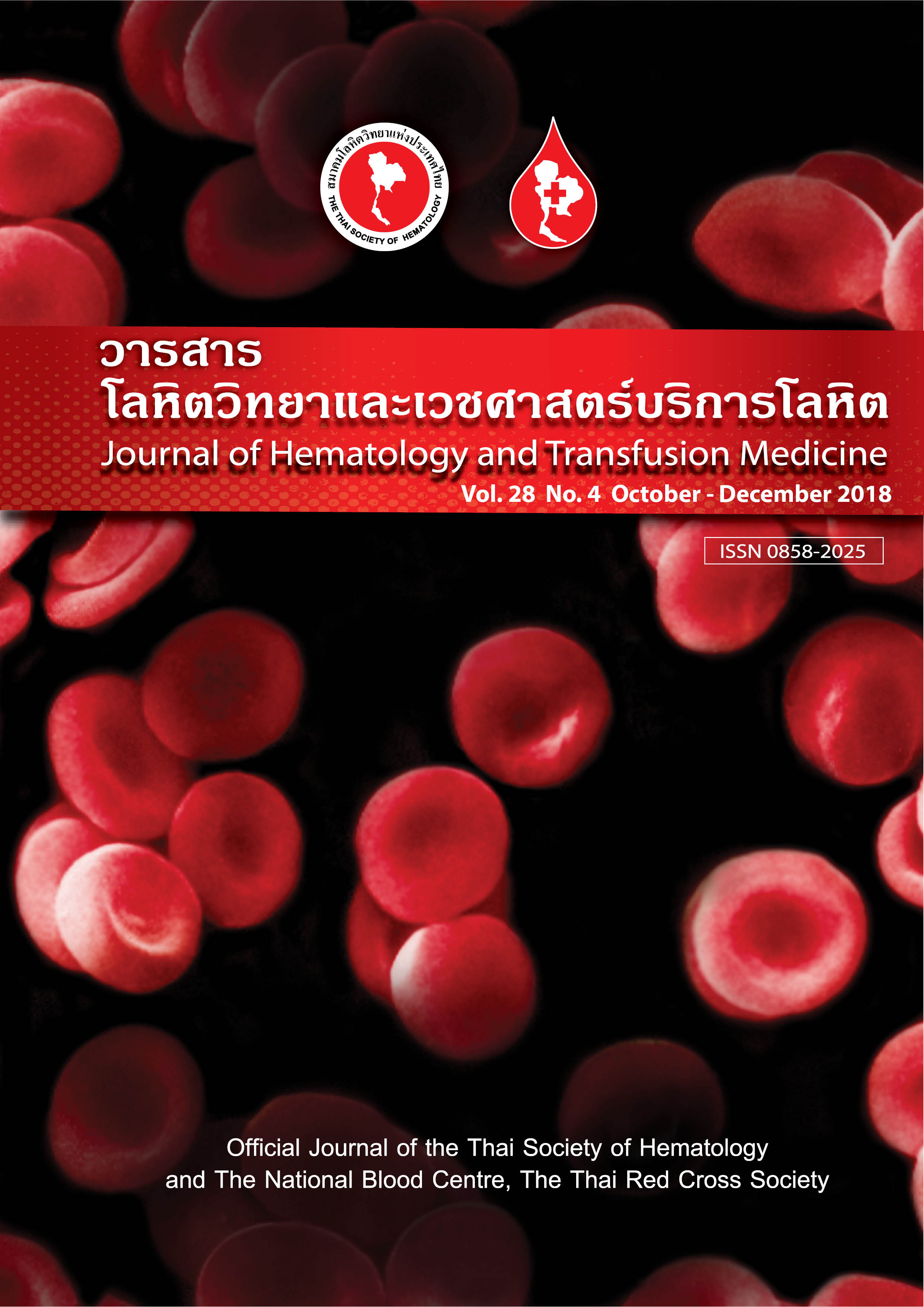การตรวจแอนติเจนของเม็ดเลือดแดงในโลหิตบริจาค เพื่อเตรียมเลือดที่ปลอดภัยให้ผู้ป่วยที่ขอใช้เลือดที่โรงพยาบาลศิริราช
Keywords:
Antigen typing, Blood donor, Safe bloodAbstract
บทคัดย่อ
ความเป็นมา เนื่องจากตรวจพบว่าผู้ป่วยที่ขอเลือดของโรงพยาบาลศิริราช มีผู้ป่วยหลายรายที่สร้างแอนติบอดี ซึ่งทำให้เกิดความล่าช้าในการจัดหาเลือดให้ เพราะจะต้องตรวจหาชนิดของแอนติบอดี และเลือกแอนติเจนที่เหมาะสม จึงได้จัดทำโครงการตรวจแอนติเจนของหมู่เลือดระบบต่างๆ ในเลือดผู้บริจาคไว้ล่วงหน้า วัตถุประสงค์ เพื่อหาแอนติเจนลบในเลือดผู้บริจาค สำหรับให้ผู้ป่วยที่สร้างแอนติบอดีทำให้ผู้ป่วยได้รับเลือดที่ปลอดภัย และรวดเร็ว วิธีการศึกษา วิเคราะห์ข้อมูลของผู้ป่วยที่มีแอนติบอดีต่อแอนติเจนของหมู่เลือดระบบต่างๆ และตรวจหาแอนติเจนในเลือดผู้บริจาคโดยการตรวจ phenotype ของหมู่เลือดระบบ Rh Kell และระบบอื่นๆ ผลการศึกษา ในระหว่างปี พ.ศ. 2556 ถึง พ.ศ. 2559 มีผู้ป่วยที่ตรวจหาแอนติบอดีจำนวน 193,813 ราย พบว่ามีการสร้างแอนติบอดี จำนวน 9,124 ราย (4.70%) ประกอบด้วย unexpected antibodies จำนวน 7,832 ราย (85.8%) ได้แก่ anti-Mia 36.7% anti-E 17.6% แอนติบอดีของระบบ Lewis 11.9% และ anti-M 3% ตามลำดับ และพบ unidentified antibodies จำนวน 1,292 ราย (14.2%) จากผลการวิเคราะห์ดังกล่าว จึงได้ทำการตรวจหาชนิดของแอนติเจนระบบ Rh Kell และ MNSในผู้บริจาคเลือด ตั้งแต่ วันที่ 1 มีนาคม พ.ศ. 2559 ถึง วันที่ 31 สิงหาคม พ.ศ. 2560 จำนวน 12,559 ราย พบ C, D, e 57.4%, C, c, D, E, e 24.3%, C, c, D, e 9.5%, c, D, E 3%, C, D, E, e 2.6%, c, D, E, e 2.1%, C, c, D, E 0.5%, c, D, e 0.3%, C, D, E 0.1%, K(+) 0.2%, Mi(a+) 9.96% และ M+ 91.0% สรุป การตรวจหาแอนติเจนของหมู่เลือดระบบต่างๆในเลือดของผู้บริจาคเลือดไว้ล่วงหน้า มีประโยชน์ในการเลือกเลือดให้ผู้ป่วยที่มีแอนติบอดี ทำให้ผู้ป่วยได้รับเลือดที่ปลอดภัย เพราะไม่มีแอนติเจนชนิดเดียวกับแอนติบอดีที่มีได้เร็วขึ้น เป็นการประหยัดเวลา และทรัพยากร
Abstract:
Background: Due to the delay in providing compatible blood for the patients who developed antibody production, red cell phenotyping in blood donors program using automated system was established at Siriraj Hospital. Materials and Methods: Retrospective data analysis of red cell antibodies in the patients was studied. In order to provide antigen negative blood for these patients, antigen typing for Rh, Kell and other blood group systems in blood donors was performed. Results: During the study between 2013 to 2016, antibody screening was done in 193,813 samples of the patients and positive results were found in 9,124 samples (4.70%), consisting of unexpected antibodies 7,832 samples (85.8%) and unidentified antibodies 1,292 samples (14.2%). The specificities of unexpected antibodies were anti-Mia 36.7%, anti-E 17.6%, antibodies of Lewis system 11.9% and anti-M 3%, respectively. Furthermore, the red cell phenotype of Rh, Kell and MNS systems was performed during 1 March 2016 to 31 August 2017. Among 12,559 samples of blood donors, we found the following phenotypes; C, D, e 57.4%, C, c, D, E, e 24.3%, C, c, D, e 9.5%, c, D, E 3%, C, D, E, e 2.6%, c, D, E, e 2.1%, C, c, D, E 0.5%, c, D, e 0.3%, C, D, E 0.1%, K(+) 0.2%, Mi(a+) 9.96% and M+ 91.0%. Conclusion: Red cell phenotyping in blood donors in advance is useful because we could provide safe blood for the patients with red cell antibodies rapidly and economically.
Downloads
References
2. Outrakoolpoonsuk K, Bejrachandra S, Saipin J, Leehaiboonsakun W, Suratanarungsan V. Detection of
red cell antibodies by enzyme technique. J Hemato Transfus Med.1999;9:103-10.
3. Lin CK, Mark KH, Cheng G, Lao TT, Tang MH, Yuen CM, et al. Serologic characteristics and clinical
significance of Miltenberger antibodies among chines patients in Hong Kong. Vox Sang.1998;74:59-
60.
4. Chandanayingyong D, Bejrachandra S. Studies on the Miltenberger complex frequency in Thailand and
family studies. Vox Sang. 1975;28:152-5.
5. Kaset C, Nathalang S, Leetrakool N, Nathalang O. Detection of MNS hybrid molecules in Central and
Northern Thai blood donors. J Hemato Transfus Med. 2015;25:101-5.
6. Annual reports. Unexpected red cells antibodies in donors and patients at Siriraj Hospital; 2013-2016.
7. Chandanayingyong D, Bejrachandra S, Metaseta P, Pongsatapon S. Further study of Rh, Kell, Duffy,
P, MN, Lewis and Gerbiech blood groups on the Thais. Southeast Asian J Trop Med Public
Health.1979;10:209-11.
8. Srijinda S, Bosuwan S, Nuanin C, Suwanasophon C. Anti-Mia and anti-E: The most common clinically
significant red cell alloantibodies in patients at Phramongkutklao Hospitial. Royal Thai Army Med
Journal. 2017;70:65-71.
9. Promwong C, Siammai S, Hassarin S, Buakaew J, Yeela T, Soisangwan P, et al. Frequencies and
specificities of red cell alloantibodies in Southern Thai population. Asain J Transfus Sci. 2013;7:16-20.
10. Butryojantho C, Junta N, Pimphumee R, Srichai S, Darunikorn P, Puapairoj C, et al. Antibody
screening and the prevalence of unexpected antibodies in the patients of Srinagarind Hospital. J
Hemato Transfus Med. 2017;27:27-33.
11. Buathong D, Hassarin S. Detection of clinically significant minor blood group antigens of blood
donors in Songklanagarind Hospital. Songkla Med J. 2016;34:109-18.
12. Nathalang O, Kuvanont S, Punyaprasiddhi P, Tasaniyanonda C, Sriphaisal T. A preliminary study of
the distribution of blood group systems in Thai blood donors determined by the gel test. Southeast
Asian J Trop Med. 2001;32:204-7.
13. Fongsarun J, Nuchprayoon I, Yod-in S. Blood groups in Thai blood donors. Thai J Hemato Transfus
Med. 2002; 12:277-86.
14. Musa RH, Ahmed SH, Hashim H, Ayob Y, Asidin NH, Choo PY, et al. Red cell phenotyping of blood
from donors at the National Blood Center of Malaysia. Asian J Trans Sci. 2012;6:3-9.
15. Australian Red Cross blood service, blood groups Rh phenotypes, [Internet].2016. Available from:
https://www.transfusion.com.au.
16. Denomme GA, Storry JR. The Rh system other blood group systems and antigens. In: Fung MK, Eder
AF, Spitalnik SL, Westhoff CM, editors. Technical manual.19th ed. Bethesda, MD: American
Association of Blood Banks; 2017. p. 295–348.



